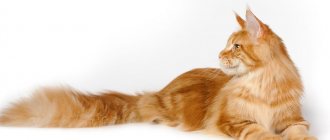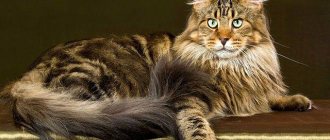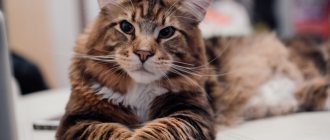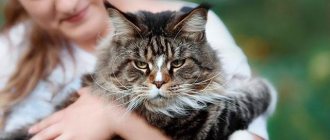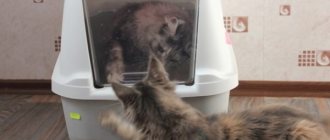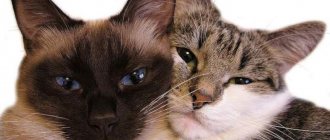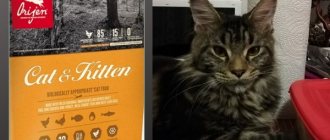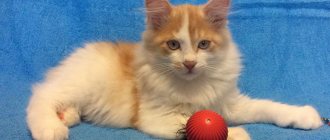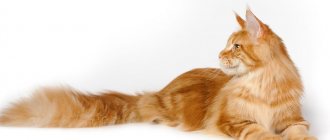Exhibition standards do not provide for haircuts for cats. Despite the fact that animals do not enjoy such interference in their natural environment, some owners do not refuse grooming. But the Maine Coon can be called an exception to the rule - cats love water and bathing is not stressful for them. But the big cat must be accustomed to other hygiene procedures from childhood.
Do I need to cut my Maine Coon's hair?
There are different points of view - from a categorical “no” to a confident “yes”. In general terms, the conclusion sounds like this: you can trim the wool, but it would be better not to do this, but limit yourself to cutting for hygiene purposes.
- Most often, Maine Coons are cut for several reasons.
- Long-haired cats develop mats. An extremely unpleasant situation where the fault lies entirely with the owner. It is enough to devote time to your pet 2 times a week, and such phenomena will not occur.
- Long molting. This is also a common event, especially when the animal is experiencing emotional stress. The length of the coat change period can be affected by weather and humidity, food quality, sexual health factors and even the length of the day. The shorter the daylight hours and the lower the air temperature, the faster the molting occurs. But if sudden warming occurs during this period, then the cat’s biological algorithms malfunction - the hair takes a long time to fall off, the body does not understand what time of year it should prepare for. In this case, haircut does not solve the problem, but only disguises it.
- The Maine Coon actively licks itself, its long hair gets into the esophagus. Most often this ends in profuse vomiting and problems with the gastrointestinal tract. The hair clumps into clumps, forms plugs, prevents food from being properly digested, and even leads to the death of the animal. In this case, cutting may be an effective method, but you still need to contact a veterinarian and understand the causes of hair loss.
- Skin diseases, formation of growths, ulcers, flaking and dandruff in cats. In this case, a haircut will help facilitate access to problem areas and make their treatment more comfortable. But you still have to identify and neutralize the cause of the disease.
Traditional hygienic grooming is not in doubt, and its benefits are not in dispute.
Important! Sometimes the grooming of Maine Coons is explained by another reason - to avoid washing. But bathing usually brings genuine joy to this cat, and a high-quality haircut always involves working with clean fur.
Where to buy a kitten
Probably, it is not worth saying that it is under no circumstances worth buying a kitten of such a rare breed on the market. Buying a charming Maine Coon baby, the price of which is from 25 to 40 thousand rubles, is necessary only in a specialized nursery.
Today we introduced you to a rather rare breed of cat in our country. We found out how the weight of a Maine Coon changes over the months and what kind of care this animal requires. We hope that the information is useful to you and that you will have such a beautiful and very kind pet.
The dangers of grooming a Maine Coon
As for the risks when grooming cats, there are few of them, but each has a very specific natural background.
- A cat's fur prevents hypothermia, so a short-haired Maine Coon's normal heat exchange, which is ensured by long hair, is disrupted. So, in the summer heat, cutting your hair can only harm your health and cause heat stroke.
- Haircut affects the condition of the skin. Without wool, it is easily susceptible to mechanical and negative natural influences.
- The structure of the coat deteriorates. The new hair does not have the necessary thickness and elasticity parameters that were inherent in the Maine Coon by nature. It quickly becomes tangled and the owner has to trim the pet regularly.
- When molting, the Maine Coon's coat is renewed unevenly. The undercoat always changes twice a year, but the guard hair never falls out completely. It is much stronger, less subject to seasonal changes and is rarely updated. When cutting, this moment cannot be foreseen; all the wool is cut evenly. In the future, the Maine Coon remains for a long time without its signature luxurious hairstyle, for which the guard coat is responsible.
- Cats also have vibrissae on their bodies - sensitive elements, without which a shaved Maine Coon loses the ability to navigate in space.
This is interesting! Experts believe that Maine Coons, after a haircut (especially not professionally), never return to their original appearance, and the growing hair forever loses some of its natural properties.
Is hair cutting dangerous?
While trying to help your pet, you can seriously harm him by cutting his hair.
Why the procedure can be dangerous:
- Thick, voluminous coat helps Maines maintain natural thermoregulation. Air is trapped between layers of wool. It keeps you warm in cold weather, protects from drafts, and in summer it saves you from heat, maintaining normal body temperature.
- The unusual fur of Maines helps the cat navigate in the dark. Coarse hairs located throughout the cat's body are tactile and help to sense the space around them.
Wool helps Maine Coons navigate in the dark
- Along with the fur, spatial orientation is also lost, and the cats feel lethargic and want to hide.
- After cutting, the structure of the hair changes and the fur becomes soft, begins to tangle, and may even not reach its full length.
Preparing for the Maine Coon grooming process
Grooming Maine Coons is carried out in the following order:
- wool preparation;
- bathing;
- haircut (if necessary);
- ear cleaning;
- oral and dental hygiene;
- nail trimming;
- eye treatment.
Each item has standard action algorithms:
- Preparation consists of basic degreasing. To do this, apply a special cream to dry wool. The first thing to do is treat the tail. It is necessary to distribute the product over the entire length of the hair. Salting of the hair on the tail is typical for purebred cats, but it is recommended to carefully treat both cats and kittens. In them, this part of the body begins to become dirty from 4-5 months of age.
- Next, the composition is distributed over dry hair in the collar area and around the ears. Here you don’t need to rub it in, but simply apply it to your hair in an even layer.
- The final stage concerns the processing of the cat's body.
- After applying the cream, wait a few minutes and wash it off with plenty of water. The wool should be completely wet, the moisture reaching the skin itself. The cat's ears fold neatly back to safely wet her head.
- Apply shampoo to the wet coat, rub in thoroughly (you can use brushes or other devices), paying special attention to the depth of penetration of the product on the tail, in the area of the pants and collar.
- The shampoo is completely washed off with water, the procedure can be repeated several times. It all depends on how often the Maine Coon bathes. This completes the degreasing.
- The next stage is the use of coloring shampoo. It is different for each color, and therefore is applied separately to areas of the coat of the corresponding color.
- The final point is conditioning. The hair “closes”, again acquires natural lubrication, becomes silky and beautiful.
Bathing a Maine Coon with newly grown hair may be more problematic than with other animals. The reason is that the cat has not yet developed new guard hairs, and the thick undercoat has too fine a structure and gets tangled in the groomer’s hands.
Important! When using any animal detergents, you must strictly follow the instructions for use.
How to distinguish a purebred kitten when buying
Distinctive features of the Maine Coon breed that will help you avoid making mistakes in choosing a pet.
Characteristic signs
- At 5 weeks, the size of a Maine Coon corresponds to the parameters of a regular six-month-old kitten; at 4-5 months they reach the size of an adult cat.
- The eyes are almond-shaped and slanted; other cats have round eyes.
- Large ears are located perpendicular to the head, there is no forward tilt. Wide at the base, they gradually taper upward, and tassels are observed at the tips - an exceptional external sign that most often appears by 3 months, although sometimes it can already be present at birth.
- The length of the head is greater than the width, so it is slightly elongated. The cheekbones protrude significantly, which is not the case in ordinary domestic kittens. The features are clear. A “box” is formed in the area of the mustache and chin, which makes the muzzle square.
- Large paws with fur between the claws.
- The tail is 2 times longer than that of ordinary kittens.
- Thick coat of medium length.
- The body is strong, the bones are massive, and the chest is wide.
Regular kitten and Maine Coon
There are some differences between a Maine Coon and a regular kitten. Breeders monitor intraspecific crossbreeding so as not to lose the characteristics of a purebred cat. Pets are born weighing 100-150 g, and by 3 months they grow to 2-2.5 kg. Strong and active, they develop quickly. Eyes open early.
The coat is fluffy and thick from the moment it is born. Powerful chest. The head is extended upward, as the length is greater than the width. The tail is long and bushy, and the paws are large with hair between the claws. They begin to eat regular food at an early age.
The guarantee of an animal's thoroughbredness is its pedigree.
A newborn ordinary kitten weighs 80 - 100 g. By 3 months the weight is only 1-1.5 kg. Small and blind, they rest a lot. Less active and late trying to get on their paws.
They feed on mother's milk for a long time and only with the appearance of their first teeth do they switch to food.
It is worth purchasing a pet from 3 months, at this moment the signs of a purebred pet will be clearly expressed. And you certainly can’t go wrong on how to distinguish a Maine Coon from an ordinary kitten.
Differences from mestizo
Crossbreeds still occur, although interbreed matings are prohibited. It is difficult to distinguish a mestizo from a real Maine Coon, since the former have the external features of purebred pets. It is better to consult a specialist who will help you determine whether the cat in front of you is a purebred or a fake.
A Maine Coon is considered purebred if ancestors in 4 generations are mentioned in the pedigree. Outbred and mixed animals only have a veterinary passport, which the owners do at their own request. Pedigree records are not issued.
A distinctive feature of a purebred pet is its size. The weight of an adult Maine Coon is at least 6-7 kg. Also, mixed-breed kittens look much smaller than their purebred counterparts.
You should also pay attention to the cost of the pet: mixed breeds are sold at a lower price than purebred ones.
Siberian kittens and Maine Coons
When comparing kittens of two species, you can see their pronounced similarity to their wild forest counterparts: Maine coons resemble lynxes in their habits, and Siberian kittens are remotely similar to manul cats.
Maine Coons have an elongated body with a long neck. The muzzle, as if chiseled, with sharp transitions, strongly pronounced cheekbones, with a clearly defined chin located in line with the nose, is one of the features of these cats. The ears point upward and have tassels at the tips.
In addition, this breed has large slanted eyes, which can only be found in purebred representatives. They have different colors. Only varieties of chocolate, fawn, cinnamon and acromelanic combinations are considered not to have received recognition.
Siberian kittens are more densely built, they have a short and powerful neck. The lines of the muzzle are smooth, the chin is rounded, the cheekbones are set low. Deeper and wider chest. The ears are round, slightly tilted forward.
The roundness of the back is also observed. Siberians have shorter paws, which is why the Maine Coon is much taller.
Exhibition grooming of Maine Coons
In addition to the haircut, the Maine Coon will have to endure several more unpleasant procedures.
- Cleaning your teeth, gums, and palate is done using special brushes and appropriate pastes. If the animal is accustomed to this activity from childhood, then no problems arise.
- Treatment of the auricle - the upper part is wiped with cotton swabs, and it is recommended to take drops for the inner area of the ear canal. They easily penetrate the ear, neutralize the dirt and wax deposits accumulated there, do not cause pain and are not capable of harm.
- It is best to trim the claws before bathing - the Maine Coon will not be able to accidentally inflict a deep wound on the owner or a visiting specialist.
- Treatment of the eye area and nose - remove traces of tears or purulent discharge, clean the hair around the pupil and nose.
Important! Owners who groom Maine Coons themselves should be aware that any manipulation with scissors is prohibited in the muzzle area, on the sideburns, collar and around the ears.
Grooming a Maine Coon at home
The owner who decides to cut his Maine Coon's hair needs to learn the basic rules. They must absolutely not be violated. In pursuit of beauty or practical benefit, it is important not to harm the cat.
- Only high-quality and clean tools are used.
- Before cutting, the cutting surfaces are disinfected.
- Grooming procedures are not carried out during periods of cat sexual activity.
If your Maine Coon has been groomed before and doesn't like it, he may react aggressively to the new challenge. Therefore, experts sometimes recommend giving a limited dose of harmless sedatives.
There are two main types of haircuts for Maine Coons:
- “Lion style” - the Maine Coon is left with a luxurious mane up to the shoulder blades, a small tassel at the tip of the tail and overgrown paws. All other areas are shaved with a clipper, and closer to the genitals they are carefully trimmed with scissors.
- Decorative hairstyle is an easier way to trim your Maine Coon yourself at home. The Maine Coon's body needs to be shaved with a clipper, leaving hair only on the head and chest. The legs and tail are overgrown, but with short hair.
You shouldn’t experiment with other haircuts on your own - a cat’s hair is difficult to style, and different lengths of hair will give the animal an unkempt appearance.
How do owners justify cutting their pet's haircut?
Two arguments can be heard from their lips. Both are insolvent.
Mats often appear in the wool
There are a lot of blasphemous videos on the Internet about grooming cats. With a machine in hand, mostly groomers from the USA, without thinking at all about the consequences, shave the animal's groin, armpits, hind legs and under the neck.
At the same time, they all seem to be firmly convinced that Maine Coons do not need fur there at all. The fashion for such cutting came from dog groomers. Indeed, these places in cats are most susceptible to the formation of tangles.
Firstly, this happens during the shedding period, and secondly, small particles and crumbs of filler can get into the wool and tangle it. Once noticed, tangles can be easily eliminated by combing the fur or carefully disassembling it using auxiliary products (for example, Pek conditioner by Iv San Bernard). And only if the initial stage of tangle formation is missed, you need to take up the scissors.
You need to cut it carefully. Large mats are located very close to the skin. The situation is further complicated by the fact that the animal’s skin in these areas is thin. Please note that getting feces and urine on your pants can also cause tangles. It would be a good idea to review the animal’s diet and have its health checked by a specialist.
The animal is hot
Don’t think that by cutting your cat’s fur during the hot season, you are making its life easier. “Extra” wool, in your opinion, actually plays a huge role in the thermoregulation of the animal. In particular, the Maine Coon's fluffy fur coat protects it from temperature changes, i.e. helps him cope with the heat.
Lack of fur reduces the animal's body's ability to withstand high temperatures. A groomed pet can easily overheat to the point of heatstroke, while an overgrown cat is not in danger of this.
Maine Coon care after the procedure
If your cat is groomed for the first time, she will almost certainly exhibit a stress reaction. At this time, while the Maine Coon gets used to new sensations, he may hide and even lose spatial orientation. It is necessary to support your pet and ensure that it is free from emotional stimuli.
Food is sometimes called one of the best ways to calm a trimmed Maine Coon a little - the cat is distracted by its favorite treats and life without fur no longer seems so terrible to it.
Some time after the haircut, the regrown hair will look like tow. This visual effect occurs due to the undercoat, which grows much faster than the outer coat. It needs to be combed out carefully and often - thin hairs get tangled easily and can form into one continuous “felt” tangle.
Otherwise, the organization of care for a shorn Maine Coon is no different from procedures for overgrown cats.
Maine Coon haircut: pros and cons
Objectively, there is not a single significant circumstance for which regular hair trimming of an adult cat can be recommended. Owner reviews contain virtually no important information about the need for such a procedure.
| The effect of haircuts on physical health | Rather negative |
| The influence of a haircut on the psychological state | Negative |
| Quality of regrown wool | Depending on the physical condition of the Maine Coon, but most often worse than its natural hair |
| The effect of haircuts on skin health | Neutral or negative |
| Impact on communication with other pets | Negative |
| Appearance | Attractive immediately after a quality haircut (short-term) |
| Improved color after haircut | Not visible |
In order for a shorn Maine Coon to grow rich, crumbly fur again, the owner will have to work hard. Efforts aimed at achieving this goal will require more labor than weekly combing and maintaining the natural fur coat of a domestic giant. In any case, whether to cut your hair or not to cut your hair is a decision everyone makes for themselves.
Varieties
Despite its American origin, the breed was established and developed mostly on European territory.
Local breeders were developing new lines. As a result, certain external signs and character traits characteristic of modern Maine Coons have become established.
This is how two varieties of this breed were formed: American and European.
American type
Cats of this species are classic representatives. American breeders work to preserve their original appearance and purebred quality.
Aborigines have a number of distinctive features, the main of which are:
- strong skeleton;
- well-developed muscle tissue;
- wide chest;
- voluminous skull;
- high forehead;
- short muzzle;
- round eye shape;
- high-set small ears;
- long whiskers;
- bushy tail;
- very thick and long hair;
- pronounced tabi color with a clear contrasting pattern.
European type
In the 70s of the 20th century, breeders managed to develop a new intrabreed variety. European Maine Coons are significantly different from Aboriginals. They are characterized by the following signs:
- extended body;
- elongated wedge-shaped muzzle;
- low forehead;
- high-set large ears with “lynx” tassels;
- slanted, oval-shaped eyes;
- high limbs;
- a long tail;
- moderately pronounced coat, lack of a lush mane and “pants”;
- plain smoky color.
In addition to “pure” representatives of each type, there are individuals that combine the external features of both varieties.
